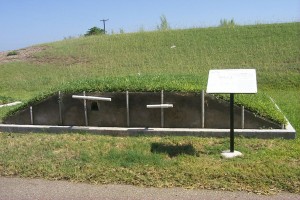 A mound system for wastewater treatment is a soil absorption system placed above the natural surface of the ground. In pressure-dosed mounds, primary treated effluent is dispersed into carefully chosen fill of permeable, well-drained sands which contain a high volume of free air within the pore space.
A mound system for wastewater treatment is a soil absorption system placed above the natural surface of the ground. In pressure-dosed mounds, primary treated effluent is dispersed into carefully chosen fill of permeable, well-drained sands which contain a high volume of free air within the pore space.
Because the effluent is distributed over a large area of sand, it moves slowly through the fill material and is in contact with air as it percolates downward. An elevated mound system is built above the native soil to achieve the required separation distance between the infiltrative surface and the limiting soil condition of the site. A mound has 1 to 2 feet of treatment media. The main goal is to preserve and utilize the natural soil conditions at the site. The wastewater must move into unsaturated soil in order for the microbes in the soil and in the biomat to feed on the waste and nutrients in the wastewater.
The components of the system include a septic tank for pretreatment, a pump with a small diameter pipe network, and an absorption area. The mound itself is a layered structure consisting of a topsoil cap, a layer of sandy loam, a geotextile layer, a low-pressure distribution system, and an absorption area.
Several variations of mounds are used in many locations. These include areal fill systems, Wisconsin mound systems, raised beds, and others. These options reflect substantial variations in requirements for dosing/gravity distribution, design, application rate, and construction methods. Despite the differences, these variants can be operated and maintained in a fashion similar to the mounds previously described.
Related Resources:
 Operation and Maintenance Checklist: Bottomless Sand Filters and Mounds
Operation and Maintenance Checklist: Bottomless Sand Filters and Mounds
 Mound System (and in Spanish)
Mound System (and in Spanish)